#Diya Holder
Explore tagged Tumblr posts
Text

It Is An Integral Custom Or Tradition To Start All The Auspicious Events By Lighting The Lamp To Create A Spiritual Atmosphere. The Set Of 2 Unique Hanging Butterfly Diya Sets With 2 Electric Diya, A Pooja Thali Decorative Item For The Festival, Adds Charm To Your Surroundings. Balcony Decoration Items Outdoor Are An Essential Part Of Diwali Decorations. The Eye-Catching Wooden Diyas For The Pooja Room Is A Traditional Diya Lamp Handcrafted With Love. Used Since Ancient Times As A Decoration And A Source Of Light. These Beautiful Balcony Decoration Items: A Unique And Vintage Look To Your Puja Room. Bring This Balcony Decor Item To Your Home And Get A Divine And Spiritual Feel At Home. The Ethnic Embellishment Is Meant To Bring Good Spirits To Your Home And Brings Enlightenment To The Decor And Is A Perfect Decoration For The Joyous Celebrations Of Life. Enhance Your Festive Decoration With This Beautiful Hanging Flower Pots For Balcony.
0 notes
Text

Wall Hanging Tealight Candle Holder
A new range of Wall Hanging Tea light Candles is available. It will brighten your dull interior and is useful for lighting the dining table for candlelight dinner or for lighting at parties. You can also gift this item to your loved ones and relatives.
Purchase This Wall-Hanging Tealight Candle Holder from Puja N Pujari.
#spiritual#temple#hinduism#festival#pooja#ritual#india#tea light candles#tealight holder#diyas#diwali#november#monday
0 notes
Note
hey, we’d love a ship for the special, a transharmful hyperfemme, a transharmed dogboy
thank you so much!!!
i hope you enjoy these two! ^^

Name: Lilith, Maeve, Diya, Sabrina, Eden,
Age: 20
Gender: female
Pronouns: she/her
Sexuality: straight
Species: human, transFae
Source: brainmade
Roles: social protector
cisIDs: blonde, blue eyes, hyperfem, anger issues, god complex, NPD
transIDs: transInnocentHarmful, transCuteHarmful, transAbusive, transEvil, transAutistic, transBPD, transOwner, transFangs, transWings
Paraphiles: sadist, MAP, somnophilia, haemotophilia, traumaphilia, oplophilia, hoplophilia, dacryphilia, autohybriphilia, zoophilia, hebephilia, ephebephilia, acrotomophilia, dopephilia
Other Labels: super possessive over her partner
Appearance:

Name: Kit, Tommy, Connor, Tobias, Evan, Morgan, Finley, Zak, Keegan, James, Maurice, Dylan
Age: 16
Gender: male
Pronouns: he/him
Sexuality: bisexual
Species: dogboy
Source: brainmade
Roles: trauma holder, punching bag
cisIDs: dogboy, dog eats, dog tail, fangs, brown hair, red eyes, PTSD, panic attacks, DPD, autistic
transIDs: transBPD, transHarmed, transAbused, permaVictim, transOwned, permaCollared
Paraphiles: masochist, AAM, somnophilia, haemotophilia, traumaphilia, oplophilia, hoplophilia, autodacryphilia, hybriphilia, autozoophilia
Other Labels: will follow partner around constantly
Appearance:

hope you enjoy them! feel free to change whatever you want! ^^
-mod richie
7 notes
·
View notes
Text
Rituals and Symbolism: Parsis in Gujarat
From: In memory of Greater Iran: Zoroastrians of Navsari Photography and captions: Sarah Jabbari Source: Sahapedia
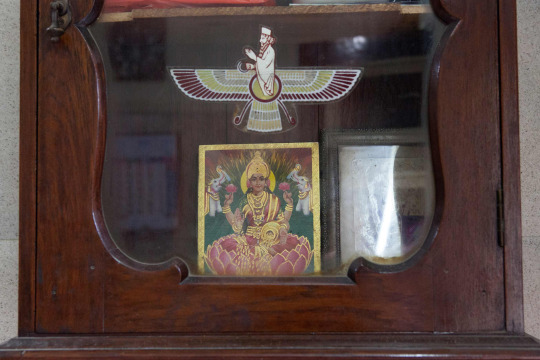
" 'God is one' is a common idea among Parsis of India, therefore religious icons from non-Zoroastrian religions are also kept in their house and workplace. A sticker of Farre Kiyani (top) share space with Laskhmi (bottom), the Hindu goddess of wealth and prosperity. The symbol of Farre Kiyani (also referred to as ‘Fravahar’ in Iran and India) is a depiction of divine protection of God on people through the wise righteous king. The symbol is very ancient and has been represented in the art of the Achaemenid Empire (550–330 BCE) and is widely used as a symbol of national identity among modern Iranian people and symbol of religious identity among Parsis of India."
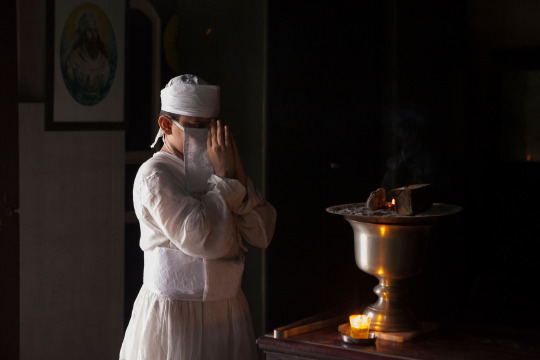
"Mobed Ayush Sharukh Desai offering prayers as part of his initiation to priesthood. Sharukh is from the Desai family of priests, who occupy a high status in the Parsi society at Navsari. The fire-holder in which the sacred fire is held is called Afargan, and it must be placed on a marble stone. Sandalwood is usually burnt in the Afargan and a small diya is also lit next to it. During the ceremony, priests cover their mouth to avoid contamination of the fire. Even the hair must be entirely covered by wearing a turban or a skull cap, because in Zoroastrianism, fallen hair is considered impure."
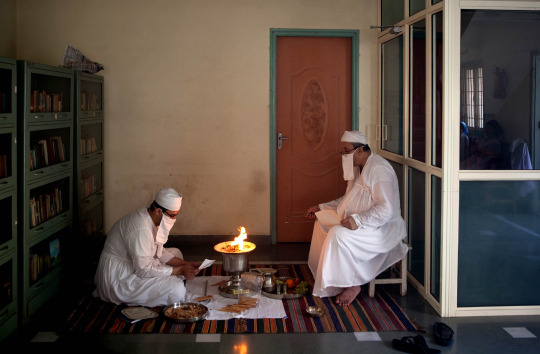
"Priests doing the Jashan ceremony at the house of Mrs Keshmira, for blessings of the family members. The word Jashan is a latter form of the word ‘yasna’ which means veneration. Jashan is a simple ceremony, can be held on any day of the year. In this ritual, Ahura Mazda, the Fravashis, Daham Yazad and Sarosh Yazad are invoked by the recitation of certain prayers. Participation in a Jashan ritual by Zoroastrians is considered as an act of great merit."
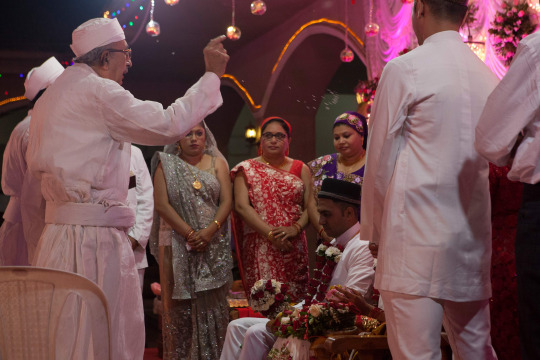
"The marriage union is called Payvand-e-Zanshooi, meaning the union of matrimony. A couple of Zoroastrian priest, one from the bride’s side and one from the groom’s side, perform the rituals on the day of the wedding. The priests face the couple, and family members form a circle around them while Avesta prayers are recited and rice thrown on the couple. All participants must be standing during the ceremony which takes about one hour, and all heads must be covered. Non-Zoroastrian or a Parsi without sudra and kushti or without hair covering are not allowed to stand in the circle."The marriage union is called Payvand-e-Zanshooi, meaning the union of matrimony. A couple of Zoroastrian priest, one from the bride’s side and one from the groom’s side, perform the rituals on the day of the wedding. The priests face the couple, and family members form a circle around them while Avesta prayers are recited and rice thrown on the couple. All participants must be standing during the ceremony which takes about one hour, and all heads must be covered. Non-Zoroastrian or a Parsi without sudra and kushti or without hair covering are not allowed to stand in the circle."
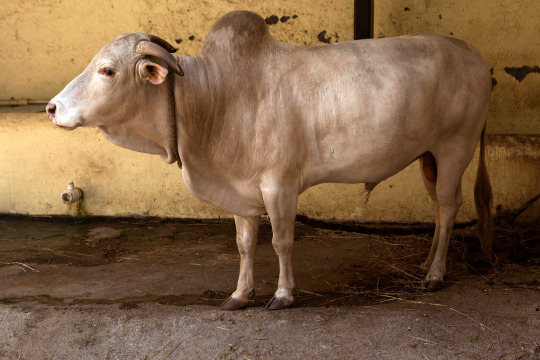
"The white bull is considered a sacred animal in Zoroastrianism; in Gujarati it is called Varasyaji. The bull is kept at the Doongerwadi because the urine (Taro) of this virgin bull is used in ritual cleansing of the dead body during funerary rites. The Varasyaji is an albino, hence very rare to find. The bull must be completely white, without even one black hair. Even the eye lashes and tail hair is white. According to Zoroastrian mythology, Varasyaji is a representation of Gava-ayok-daat, which is the first animal created by Ahura Mazda. It got killed by the Devil, Ahreeman, but many other animals, plants and minerals were created out of its dead body. It is born as the Pesh Ruwan (spiritual leader) of the animal kingdom."
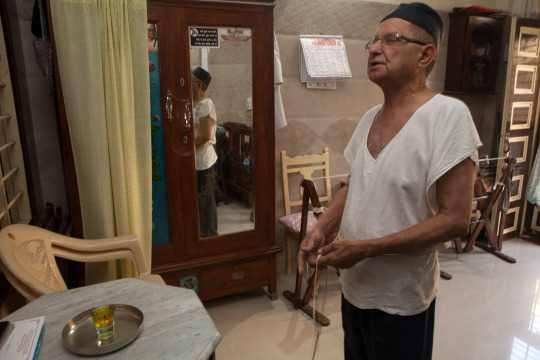
"Wearing the sudra and kushti is an essential part of the daily lives for Zoroastrians. Wearing the Sudra is believed to offer protection from evil. This act of untying and tying the kushti is supposed to be done five times (though not every kushti wearer sticks to that number) in a day and the act is called Nirang-i-Kushti. Here, Mr Kersi Patel is at his daily prayer performing Nirang-i-Kushti. When doing the prayer, he unties the kushti from around his waist and holds it up in both hands, the strand doubled over, and lifts it to touch the forehead and eyes."
#parsi#navsari#gujarat#rituals#zoroastrianism#religion#priest#sahapedia#mobed#jashan#avesta#wedding rituals#symbols#sudra#kushti#lakshmi#personal archive
7 notes
·
View notes
Text
Enhance Your Home Decor to Welcome Maa Laxmi with Grace
In the rich tapestry of Indian culture, the festival of Diwali holds a special place. Diwali, also known as the Festival of Lights, is celebrated with great enthusiasm and devotion. It is a time to welcome Goddess Lakshmi, the deity of wealth and prosperity, into our homes. To make this festival even more special, we can enhance our home decor to create a warm and inviting ambiance that welcomes Maa Laxmi with grace.
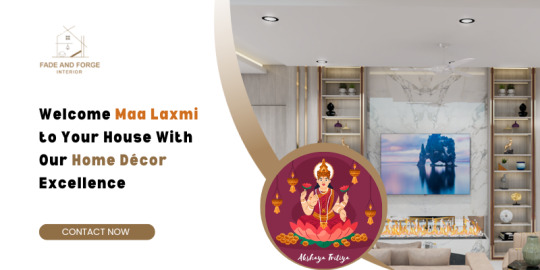
Here are some creative ways to elevate your home decor this Diwali and create a serene atmosphere that will surely attract blessings from the goddess of wealth.
Illuminate with Diyas and Candles
Lighting plays a significant role in Diwali celebrations. Traditionally, diyas (oil lamps) are used to light up homes. You can place these around your house, especially near the entrance and in the temple area, to symbolize the triumph of light over darkness. You can also incorporate scented candles in beautiful holders to add a modern twist to the tradition.
Rangoli Art
Rangoli is an art form where intricate patterns and designs are created on the floor using colored powders, flower petals, and other materials. This not only adds a visual appeal to your home but is also considered an auspicious tradition. You can experiment with various designs and colors to create a vibrant and welcoming atmosphere.
Flower Decor
Fresh flowers are a timeless element of Indian home decor. You can use marigold garlands, rose petals, and other colorful flowers to adorn your living spaces. Flowers bring a natural and fragrant charm to your home, creating a pleasing ambiance for the goddess.
Color Schemes
Colors have significant symbolism in Hindu culture, and each color holds its own meaning. Red symbolizes sensuality and purity, while yellow represents knowledge and learning. Incorporate these colors into your decor through cushions, drapes, or tableware to create an inviting and culturally rich atmosphere.
Art and Statues
Decorate your home with images or statues of Goddess Lakshmi and Lord Ganesha, who is revered as the remover of obstacles and the god of wisdom. These divine elements not only infuse your home with spiritual significance but also enhance the overall aesthetic.
Create a Prayer Corner
Designate a serene corner of your home as a prayer or meditation space. Place idols, incense burners, and essential oil diffusers here. This sacred space will not only welcome the goddess but also offer you a tranquil sanctuary for spiritual contemplation.
Textiles and Upholstery
Introduce silk or brocade fabrics into your decor, either in the form of cushion covers, curtains, or tablecloths. These luxurious textiles not only add elegance to your home but also symbolize opulence, which resonates with the spirit of Diwali.
Floating Candles and Flower Arrangements
Create a serene atmosphere by placing floating candles and flower arrangements in bowls or glass containers. This simple yet visually appealing decor adds a touch of serenity to your home, making it a welcoming abode for the goddess of wealth.
Wall Art and Murals
Consider adorning your walls with Diwali-themed art or murals that depict the beauty and significance of this festival. These pieces can act as a conversation starter and create an immersive atmosphere.
Conclusion
Diwali is a time of reflection, gratitude, and celebration. It's an opportunity to welcome Goddess Lakshmi with open arms and create an atmosphere of abundance and prosperity. By thoughtfully enhancing your home decor with traditional elements and a touch of modernity, you can make your home an inviting space not just for Maa Laxmi, but for your loved ones as well. Embrace the cultural richness and spiritual significance of Diwali, and watch as your home radiates with grace and beauty, filling your life with wealth and prosperity. Happy Diwali!
Click to read more.
2 notes
·
View notes
Text
Buddhism, founded by Siddhartha Gautama in ancient India, transcended its birthplace to become a major world religion. Here's a detailed look at the factors that facilitated its spread: Monks and Missionaries: Tireless Messengers of the Dharma SN Handicrafts Sitting Buddha Handicrafts Sitting Buddha Idol Resin Statue Showpiece for Living Room Home Decor and Gifts-with Wooden Flowers Natural Stone Tealight Candle Holder and Wooden Tray Monastic Tradition: The Backbone of Buddhist Propagation The monastic tradition lies at the very heart of how Buddhism spread throughout Asia and beyond. Here's a closer look at the role of monks and nuns ( bhikkhus and bhikkhunis) in this process: Dedicated Practitioners: Monks and nuns devote their lives to studying, practicing, and upholding the Buddha's teachings. This commitment allows them to become exemplars of Buddhist principles. Dharma Bearers: They act as custodians of the Dharma, memorizing and transmitting vast amounts of scripture and oral traditions. This ensures the teachings remain accurate and accessible for future generations. Missionaries on the Move: Early on, monks and nuns took the initiative to travel beyond India's borders. They established monasteries in new regions, serving as centers for learning, meditation, and community. Living Example: Their simple and disciplined lifestyle, based on the monastic code (Vinaya), provided a living example of the Dharma's transformative potential. This attracted lay people who might not choose monastic life but were inspired by its ideals. Education and Guidance: Monks and nuns offered education in Buddhist philosophy and meditation practices to both laypeople and aspiring monastics. This helped propagate the religion and nurture a deeper understanding of the Dharma. Cultural Exchange: As they traveled, they interacted with diverse cultures. Monks and nuns facilitated cultural exchange by incorporating local artistic styles and traditions into Buddhist art and architecture. The dedication and commitment of Buddhist monastics were instrumental not just in spreading the religion but also in preserving its core teachings and practices. They continue to play a vital role in sustaining Buddhist communities worldwide. Easyera Beautiful Lotus Tealight Holder Small Lotus Candle Holder For Indoor and Out Door Decorative Showpices Lamp Gifting Decor, Diwali Diya Golden Floor Rangoli Metal Lotus For Decoration Ashoka's Edicts: Carving Dharma in Stone Emperor Ashoka, a convert to Buddhism, actively promoted its spread. He sent missionaries to neighboring lands, including Sri Lanka, Southeast Asia, and Central Asia. Emperor Ashoka, the Mauryan ruler who reigned from 268 to 232 BCE, stands as a pivotal figure in the spread of Buddhism. His conversion to Buddhism after witnessing the horrors of war led him to embrace a new path of righteousness (Dharma). A key element of this transformation was the creation of the Edicts of Ashoka. Disseminating the Dharma: Etched in Stone: Ashoka commissioned the carving of his edicts onto pillars, boulders, and cave walls throughout his vast empire. These inscriptions, spread across present-day India, Pakistan, Nepal, Afghanistan, and Bangladesh, ensured a wide reach for his message. Focus on Morality: The edicts don't delve deeply into Buddhist philosophy, but rather emphasize ethical principles aligned with Dharma. These include non-violence (ahimsa), respect for all religions, filial piety, social responsibility, and concern for animal welfare. Leading by Example: Ashoka's edicts highlight his own remorse for past violence and his commitment to upholding Dharma. This served as a powerful message to his subjects, encouraging them to follow his example. Impact and Legacy: Spreading the Message: The edicts, written in local languages, were accessible to a large audience. They likely played a significant role in promoting Buddhist values and ethics beyond the confines of the monastic community.
A Historical Treasure: Today, Ashoka's edicts stand as invaluable historical documents. They provide insights into Mauryan society, the development of Buddhism, and Ashoka's unique approach to governance. Limitations to Consider: Limited Scope: The edicts primarily targeted Ashoka's own subjects, and their direct influence on the spread of Buddhism beyond the Mauryan Empire might be debatable. Interpretation and Bias: The edicts were written from Ashoka's perspective, and it's important to consider the possibility of bias or selective presentation. Despite these limitations, Ashoka's Edicts remain a testament to his commitment to Dharma and his role in shaping the course of Buddhism in Asia. Trade Routes: Highways of Dharma and Commerce Greyt Monk Dark Tealight Candle Holders Home Decor, Balcony Decor, Candle Stand, Flowers Diwali Decoration Items, Diwali Gift Items, Diwali Decoration Items for Home The Silk Road: A Highway for Dharma and Commerce This vital trade network connecting India to China became a conduit for Buddhist ideas. Merchants, often exposed to the religion, carried its message to new regions. The Silk Road, a network of trade routes connecting East and West that flourished from the 2nd century BCE to the mid-15th century, played a significant role in the spread of Buddhism beyond India. Commercial Hub: Merchants traveling along the Silk Road not only carried goods like silk, spices, and precious metals but also ideas and cultural influences. Buddhist monks, taking advantage of these established trade routes, spread their religion alongside these commercial exchanges. Monks as Travelers: Monasteries sprung up along the Silk Road, serving as resting points for traders and pilgrimage destinations for the faithful. These monasteries became centers of learning and cultural exchange, fostering the dissemination of Buddhist teachings. The Meeting of Cultures: Trade along the Silk Road led to a cross-pollination of cultures. Buddhist art and architecture incorporated Hellenistic influences from the West, giving rise to the Greco-Buddhist style seen in the Gandhara region (present-day Pakistan and Afghanistan). Apple Watch Your essential companion for a healthy life Take an ECG anytime. Get notifications if you have an irregular heart rhythm. Emergency SOS lets you call for help with the press of a button The Silk Road wasn't just a route for physical goods; it was a conduit for the exchange of ideas, philosophies, and religions. Buddhism's message of non-violence, compassion, and enlightenment resonated with many who encountered it along this ancient highway. Monks as Travelers: Barefoot Missionaries of the Dharma Monks also utilized trade routes, establishing contacts and founding communities along the way.Buddhist monks, with their simple robes and dedication to the Dharma, played a crucial role in spreading Buddhism beyond India's borders. Here's a closer look at their unique travel style and its impact: Wandering Ascetics: Early Buddhist monks followed a tradition of wandering asceticism. They traveled on foot, living a simple life on the alms received from lay followers. This mobility allowed them to reach a wider audience and establish themselves in new regions. Sharing the Dharma: Their primary purpose for travel was to spread the teachings of the Buddha. They engaged in discussions with laypeople, explaining Buddhist concepts and offering guidance on meditation practices. Establishing Monasteries: As they traveled, monks often established monasteries in new locations. These monasteries served as centers of learning, meditation, and community for both monastics and laypeople. They became focal points for the spread of Buddhism and provided a base for further missionary activity. Cultural Exchange: Monks interacted with diverse cultures and traditions during their travels. They were open to learning new customs and incorporating local artistic styles into Buddhist art and architecture. This fostered a more inclusive form of Buddhism that resonated with new audiences.
Living Example: The commitment of monks to their vows of poverty, non-violence, and ethical conduct served as a living example of the Dharma's transformative potential. This simplicity and dedication attracted followers and inspired others to explore the Buddhist path. VIOFO A229 Pro 4K HDR Dash Cam 4K +2K Dual STARVIS 2 Sensors Dash Cam 3 Parking Modes for 24/7 Protection Hands-free Voice Control & Notification Ultra-Precise GPS Logger Challenges of Travel: Hardships and Dangers: Traveling long distances on foot was no easy feat. Monks faced harsh weather conditions, limited resources, and potential dangers along the way. Their dedication and resilience were key to their success. Language Barriers: Communication could be a challenge when encountering new cultures and languages. However, monks often learned local languages to effectively communicate the Dharma's message. Despite the hardships, the spirit of exploration and the commitment to sharing the Dharma made Buddhist monks successful missionaries. Their travels left an enduring mark on the spread of Buddhism throughout Asia and beyond. Openness and Adaptability: A Welcoming Path The Universal Message of Buddhism: A Path Beyond Borders Buddhism, unlike some religions with a singular founding deity, offers a more philosophical and practical approach to alleviating suffering. This core message, transcending cultural and geographical boundaries, is what fueled its global spread. Here's a breakdown of the key aspects of this universal message: The Four Noble Truths: This fundamental framework lays bare the reality of suffering (dukkha) and offers a path towards its cessation. It acknowledges the universality of suffering and provides a roadmap for liberation. The Eightfold Path: This practical guide outlines the steps one can take to achieve liberation from suffering. It emphasizes ethical conduct (Right Speech, Right Action, Right Livelihood), mental discipline (Right Effort, Right Mindfulness, Right Concentration), and wisdom (Right View, Right Intention). Following this path is achievable for anyone, regardless of background. Non-Violence (ahimsa): A central tenet of Buddhism, non-violence extends compassion towards all living beings. This message resonates with people seeking peace and understanding in a world often filled with conflict. Compassion and Loving-kindness (metta): Buddhism emphasizes developing genuine care and goodwill for all beings. This fosters a more harmonious and connected world. Impermanence (anicca): Understanding that all things are impermanent can help us detach from clinging to desires and alleviate suffering caused by loss. Selflessness (anatta): The concept of non-self challenges the illusion of a fixed and separate self. This allows for a more open and interconnected way of relating to the world. Karma and Rebirth: These concepts highlight the principle of cause and effect, encouraging individuals to take responsibility for their actions and strive for positive actions that lead to a better future. The beauty of Buddhism's message lies in its practicality and universality. It offers a path for personal transformation and a framework for creating a more peaceful and compassionate world. This message continues to resonate with people across the globe, making Buddhism a relevant and enduring spiritual tradition Local Integration: Buddhism's Flexible Embrace One of the key factors behind Buddhism's successful spread beyond India was its remarkable ability to adapt to local cultures and traditions. This process of local integration, known as "localization" or "inculturation," allowed Buddhism to flourish in diverse environments. Here's how it worked: Accommodation and Assimilation: Buddhist teachings were presented in a way that resonated with existing beliefs and practices. For example, local deities might be incorporated into the Buddhist pantheon, seen as manifestations of enlightened beings. Artistic Expression: Buddhist art forms adopted local styles and symbolism.
For example, in China, Buddhist sculptures incorporated Chinese aesthetics, while in Japan, Zen Buddhism blended with existing Shinto practices. Translation and Interpretation: Scriptures were translated into local languages, making them accessible to a wider audience. Additionally, Buddhist concepts were sometimes reinterpreted to align with local philosophical traditions. Ritual Practices: Local customs and rituals were sometimes integrated into Buddhist practice, creating a more familiar and welcoming experience for new converts. HUION Drawing Monitor HUION Kamvas Pro 13 features a stunning with Full HD resolution, letting you enjoy immersive viewing in great clarity and fine detail. The graphics tablet display can be easily connected with 3 in 1 USB-C cable to your computer & laptops. Benefits of Local Integration: Increased Appeal: By adapting to local contexts, Buddhism became more approachable and relevant to new audiences. This flexibility made it more likely to be adopted and integrated into existing belief systems. Sustainability: Localization helped Buddhism establish deeper roots in new regions. The religion became less foreign and more integrated into the cultural fabric of the societies it encountered. Cultural Exchange: This two-way process also enriched Buddhism itself. Local traditions influenced Buddhist practices, leading to the development of new schools of thought and artistic expressions. Examples of Local Integration: Theravada Buddhism in Southeast Asia: Theravada Buddhism blended with local animistic beliefs and practices, creating a unique regional expression of the religion. Mahayana Buddhism in China: Mahayana Buddhism interacted with Confucianism and Daoism, leading to the development of new schools like Chan (Zen) Buddhism. Tantric Buddhism in Tibet: Tantric Buddhism incorporated elements of the Bon religion, an indigenous Tibetan belief system. Limitations to Consider: Balance is Key: Excessive adaptation could dilute the core teachings of Buddhism. Finding a balance between local integration and maintaining the core principles was crucial. Internal Tensions: Sometimes, local integration led to disagreements within Buddhist communities about the appropriate level of adaptation. These factors, working in tandem, propelled Buddhism beyond its Indian origins. From Southeast Asia to China and beyond, it flourished, leaving an enduring mark on the world's religious landscape.
0 notes
Text
Festive Decor Items to Light Up Your Home This Season
Shop Festive Decor Online from Chronos Lights
Chronos Lights offers a unique selection of decor items to brighten your pooja area and bring festive vibes into every corner. Our collection features captivating pieces with intricate designs and unique themes, perfect for every festival.
Explore More Home Decor & Essentials Online
From table lamps and wall accents to kitchen essentials, Chronos Lights caters to every taste and budget. Whether you���re decorating a small space or a large one, our wide range of home decor essentials breathes life into any room.
Why Choose Chronos Lights for Festive Decor?
Chronos Lights combines quality and style to offer one of the largest collections of festive decor items online. With traditional and contemporary pieces, you’re sure to find the perfect decor items for your puja room.
FAQs on Festive Decor
- How do I decorate my home during festivals?
Decorating your home is simple with Chronos Lights! Choose from fairy lights, table lamps, candles, and showpieces like god idols, wall decor, diyas, and torans. Enhance your pooja area with essential items like thalis and incense.
- What are some tips for decorating small spaces?
Choose multi-functional decor items like urli with diya, tealight holders, and string lights to add elegance without clutter.
Illuminate your home with festive decor from Chronos Lights and celebrate every festival in style! Visit us at www.chronoslights.com.
0 notes
Text
Enhance Your Pooja Room with Hanging Bells, Ram Idol, and Brass Puja Items
A well-organized and serene pooja room is essential for creating a peaceful atmosphere during your religious practices. One of the ways to elevate the spiritual ambiance of your pooja room is by adding beautiful decorative and functional items. Among these, hanging bells for pooja room, a Ram idol, and brass puja items stand out as excellent choices that bring both beauty and tradition to your sacred space.
Hanging Bells for Pooja Room

Hanging bells for pooja room are not only aesthetically pleasing but also hold great spiritual significance. The sound of the bell during pooja rituals is believed to invite positive energy, ward off negative vibes, and enhance the purity of the surroundings. The melodic sound creates a peaceful environment, making it ideal for prayer and meditation. The gentle chime from the hanging bells adds a divine touch to the atmosphere, ensuring your pooja room is filled with tranquility.
Ram Idol

A Ram idol is a beautiful representation of Lord Ram, one of the most revered deities in Hinduism. Having a Ram idol in your pooja room symbolizes righteousness, virtue, and the triumph of good over evil. Lord Ram is a figure of devotion, strength, and integrity, making his idol a perfect choice for your pooja room. Whether you choose a small brass idol or a more elaborate sculpture, the Ram idol will bring blessings, peace, and protection to your home.
Brass Puja Items

When it comes to enhancing your pooja rituals, brass puja items are an essential addition. Brass is considered auspicious in Hinduism, and items like brass diyas, plates, and incense holders are widely used during puja ceremonies. The lustrous golden color of brass adds a regal and traditional touch to your pooja room. Using brass puja items also ensures that you have high-quality and durable accessories that will serve you for many years. These items, when paired with hanging bells and a Ram idol, create a harmonious and spiritually charged environment.
Conclusion
Incorporating hanging bells for pooja room, a Ram idol, and brass puja items into your sacred space can make a significant difference in your daily worship experience. These items not only add to the aesthetic appeal of your pooja room but also bring positive energy and spiritual blessings. Whether you are setting up a new pooja room or upgrading your current one, these elements will create the perfect environment for prayer and meditation.
0 notes
Text

Unlock the Beauty of Decorated Pooja Thalis with Hi Retails
The rich tapestry of Indian culture is woven with threads of tradition, spirituality, and artistry. Within this tapestry, the pooja thali holds a special place, serving as a vessel for devotion and a canvas for creative expression. Furthermore, the beauty and significance of decorated pooja thalis are explored in this blog, with a special focus on the exquisite collection offered by Hi Retails.
The Significance of the Pooja Thali
Primarily, the pooja thali is more than just a plate; it is a sacred offering, a carefully arranged collection of items used in Hindu worship. Additionally, it symbolizes reverence, gratitude, and a connection with the divine. Subsequently, each item placed on the thali holds symbolic meaning, contributing to the overall sanctity of the ritual. Moreover, from brass diyas (lamps) that represent light and knowledge to incense sticks that symbolize purification, every element plays a crucial role.
The Art of Decoration
Furthermore, the decoration of a pooja thali elevates it from a simple object to a work of art. Consequently, traditional motifs, vibrant colors, and intricate designs are employed to enhance its aesthetic appeal. Also, flowers, rangoli patterns, and precious stones are often used to adorn the thali, making it a visual delight. Besides, this artistic expression adds another layer of devotion to the ritual, transforming it into a sensory experience.

Hi Retails: A Treasure Trove of Pooja Thalis and Brass Products
In addition, Hi Retails offers a stunning array of pooja thalis and related brass products. As well as, their collection showcases the beauty and craftsmanship of Indian artisans. For example, from traditional designs to contemporary interpretations, a wide variety of styles are available to suit every taste and preference.
Exploring the Hi Retails Collection
Moreover, the collection includes a variety of brass products. For instance, brass idols of Hindu gods, brass lamps, and other pooja essentials are offered. Also, these items are crafted with meticulous attention to detail, ensuring both beauty and durability.
Brass Idols: Adding Divinity to Your Home
Similarly, brass idols hold a significant place in Hindu worship. For example, idols of various deities are revered and worshipped in homes and temples. Further, Hi Retails offers a wide selection of brass idols, allowing individuals to bring divine presence into their living spaces. Additionally, these brass idols for home and brass idols for decoration can be purchased brass idols online and brass idols of hindu gods online. Also, for those looking for a brass idol shop near me, Hi Retails offers online convenience.
Pooja Thali Sets: Completing Your Worship Experience
Besides, Hi Retails offers complete pooja thali sets, ensuring that all necessary items are included. Additionally, these sets often include aarti thali, diya stands, incense holders, and other essential components. Therefore, these puja thali set and pooja thali online options make it easy to perform pooja rituals with ease and convenience. In addition, there are pooja ki thali and puja ki thali options available.
Aarti Thalis: Illuminating the Divine
Also, the aarti thali, used for the ritual of waving lamps before the deity, is another important element of pooja. Similarly, Hi Retails offers beautifully decorated aarti thalis, adding a touch of elegance to this sacred ritual. Moreover, aarti thali, aarti dish, aarti ki plate, aarti ki thal, aarti plate, aarti pooja thali, aarti thali buy online, aarti thali online, aarti thali set, aarti thali thali are available in different varieties.
The Beauty of Brass: A Timeless Choice
Furthermore, brass is a popular choice for pooja items due to its durability, beauty, and auspicious associations. Likewise, brass is believed to attract positive energy and create a sacred atmosphere. In addition, pure brass items, copper and brass items, decorative brass, brass and copper items, copper and brass products are available at various price of brass for customer affordability.
Gifting Traditions: Sharing Blessings
Furthermore, pooja thalis and brass items also make wonderful gift items. Likewise, they are often given as wedding present gift, wedding gift useful, wedding gifts, gifts in wedding, gift items for marriage ceremony, gift item for marriage, gift item for marriage ceremony, good gift for marriage, best gifts to give for wedding, best gift for the wedding. Additionally, these items are also considered unique gift items, unique gift ideas for sister, gift ideas to brother, gift idea for wedding couple, gift for the wedding.
Decorated Pooja Thalis: A Feast for the Eyes

Moreover, decorated pooja thalis from Hi Retails are truly a sight to behold. Also, decorated aarti, decorated aarti thali, decorated pooja plate, decorated pooja thali, decorated pooja thali online, decorated puja thali, decorated thali, decorated thali online, decorative pooja ki thali, decorative thali for puja, decorative thali online, latest pooja thali, pooja aarti ki thali, pooja aarti set, pooja decorative thali are some of the options.
#pooja thali#decorate pooja thali#brass thali#aarti ki thali#aarti thali#home decoartion#brass products#home decor#brass
0 notes
Text
eReturnGifts.com: The Best Return Gifts for all occasions at whole sale price

eReturnGifts.com offers an extensive collection of return gifts for all occasions at wholesale prices. Here's what makes the platform stand out for your gifting needs:
Why Choose eReturnGifts.com?
Wide Variety of Options: Catering to birthdays, weddings, festivals, corporate events, housewarming parties, and more, they provide gifts tailored to every occasion.
Affordable Pricing: Wholesale rates ensure you get high-quality gifts without overspending. Bulk discounts are often available.
Customization Options: Add a personal touch with engraving, name tags, or themed packaging.
Eco-Friendly Products: Emphasis on sustainable and reusable return gift options like plantable items and biodegradable products.
Nationwide Delivery: Convenient shipping options across India and even international delivery for some products.
Best-Selling Return Gifts Categories on eReturnGifts.com
1. Kids’ Return Gifts:
Pencil boxes, pouches, and stationery sets.
Educational toys, puzzles, and board games.
Cartoon-themed mugs and bottles.
2. Wedding Return Gifts:
Customized silver articles, kumkum boxes, and jewelry boxes.
Aromatic candles and traditional handicrafts.
Small idols or decorative home decor items.
3. Housewarming Return Gifts:
Planters and gardening kits.
Elegant kitchenware, coasters, or spice jars.
Feng Shui items or small sculptures.
4. Festive Gifts:
Diyas, puja thalis, or incense holders for Diwali.
Dry fruit boxes and sweets for Raksha Bandhan.
Handmade bags and eco-friendly items for all festivals.
How to Shop on eReturnGifts.com:
Browse by occasion or gift type for quick selection.
Select quantity and enjoy wholesale discounts.
Look for bulk deals and seasonal offers for better value.
eReturnGifts - Buy Premium Return Gifts Online in Hyderabad, India
eReturnGifts - Shop the Best Return Gifts Online in Hyderabad, India! Explore a wide range of unique, affordable gifts for birthdays, weddings, festivals, and more. With wholesale prices and convenient delivery, find the perfect return gifts to make your celebrations memorable.
eReturnGifts offers the best collection of return gifts online in Hyderabad, India, perfect for all occasions like birthdays, weddings, festivals, and more. Choose from unique, affordable options like eco-friendly gifts, home decor, and personalized items at wholesale prices. Convenient doorstep delivery ensures a hassle-free shopping experience.
Visit: https://www.ereturngifts.com/category/return-gifts/
#birthday return gifts#online return gifts#best return gifts#return gifts#buy return gifts#buy return gifts online#return gifts birthday#return gifts in hyderabad#buy gifts online#return gifts hyderabad#Return Gifts#Retirement Gifts#Function Return Gifts Annaprasana#Baby Shower#Bangle Ceremony#Barasala#Dhoti Ceremony#Engagement#Haldi Function#Half Saree Function#House Warming Ceremony#Mature Function#Naming Ceremony#Wedding Return Gifts#Festive Return Gifts#Christmas#Dussehra#Diwali#Ganesh Pooja#New Year Return Gifts
0 notes
Text
Decorate Your Home with Lakshmi Ganesh Idol, Tea Light Holder, and Diya for Diwali
Diwali, the festival of lights, is a time for joy, togetherness, and traditions. Decorating the home with symbolic items not only adds beauty but also invites prosperity. In this blog, we'll explore how a Lakshmi Ganesh idol, a tea light holder, and a diya for Diwali are perfect additions for your festive décor.
The Significance of Lakshmi Ganesh Idol

During Diwali, it is customary to worship Goddess Lakshmi and Lord Ganesh for wealth and wisdom. A Lakshmi Ganesh idol is an essential part of Diwali puja, bringing peace and prosperity to your home. Placing the idol at the entrance or in the puja room enhances the spiritual ambiance.
Elevate Ambiance with Tea Light Holders

A tea light holder adds a modern touch to traditional Diwali décor. These holders come in various designs and materials, perfect for creating a warm glow. When combined with diyas, they create a serene, magical atmosphere, making your Diwali celebrations even more special.
Traditional Diyas for Diwali
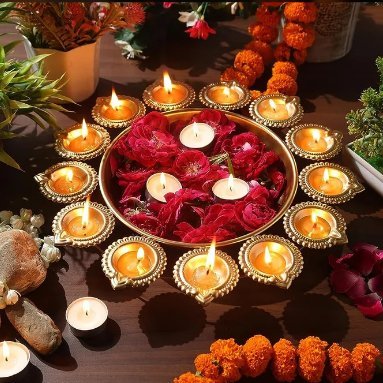
No Diwali is complete without the glow of diyas. A diya for Diwali symbolizes the victory of light over darkness. Place them around your home to invite positive energy and good fortune. You can choose from clay, brass, or decorative diyas to match your style.
Conclusion
This Diwali, enhance your home with a beautiful Lakshmi Ganesh idol, decorative tea light holders, and traditional diyas for Diwali. These elements will not only brighten your space but also fill it with divine blessings and warmth.
0 notes
Text
What Unique Designs of Silver Pooja Thalis Are Available for Purchase?
At Silver Store, we provide a wide selection of unique silver pooja thali to suit a variety of tastes and preferences. Our collection comprises finely made thalis with traditional patterns and contemporary aesthetics to complement any decor style. High-quality 925 silver makes these pooja thalis not only visually appealing but also long-lasting. Choose from a variety of sizes and sets that include useful accessories such as diya holders and kum kum boxes. Our silver pooja thalis are ideal for festivals or daily worship, adding elegance to your spiritual rituals while representing cultural value.
0 notes
Text
Price: [price_with_discount] (as of [price_update_date] - Details) [ad_1] From the brand Best Sellers Ganesha Wall Hanging Ganesha Car Dashboard Key Holders Ram Mandir Loving Swan Showpiece Bronze Idols Brass Idols Religious Paintings Diyas Incense Holder Package Content: One Handcrafted Iron Set Of 3 Lord Ganesha Wall Hangings Playing Tabla, Veena, And Dholak Musical Instruments Decorative Showpieces Product Size: 27Cm x 1Cm x 40Cm / 11" x 0.5" x 16" Material: Iron ; Color: Orange, Silver, Black Care Instruction: Don't wash, use dry/wet cotton cloth to remove dirt. The set includes three unique designs - Ganesha playing Tabla, Veena, and Dholak. These ready-to-use decorative showpieces are suitable for your bedroom, living room, or any corner of your home. Made with high-quality iron metal, these decorative items are built to last long and are durable. [ad_2]
0 notes
Text
Our Approach to Elegant and Functional Pooja Room Designs

Understanding Your Vision :
Knowing your vision starts our design process. Every homeowner has different tastes and religious habits, so, we give great importance to designing a space that fits your spiritual requirements. We discuss your ideas, tastes, and maybe particular needs during our consultation. Our designs are meant to express your beliefs and uniqueness regardless of the kind of pooja room—traditional, simple, or modern.
2. Blend of Tradition and Modernity :
We understand the balance between preserving cultural traditions and incorporating contemporary elements. For clients seeking a traditional pooja room, we incorporate materials like wood, marble, and brass, often adorned with intricate carvings or motifs. For a modern touch, we use sleek lines, glass panels, and subtle lighting to create a minimalist yet serene ambiance. Our designs ensure that functionality meets elegance, whether you prefer a standalone pooja room or a compact prayer unit within your living space.
3. Optimal Space Utilization :
In urban settings, space can be a constraint, but spirituality should never be compromised. Our expert designers specialize in maximizing small spaces to create pooja rooms that feel open and tranquil. Compact wall-mounted units, foldable altar setups, or creatively partitioned sections ensure the space is utilized efficiently without overwhelming the room’s overall design.
4. Material Selection and Craftsmanship :
Materials play a vital role in pooja room designs, as they contribute to both aesthetics and functionality. We use durable and easy-to-maintain materials such as:
Wood: Adds warmth and traditional charm. Marble: Provides a luxurious and spiritual feel. Glass: Enhances modern aesthetics while maintaining simplicity. Metal Accents: Brass or copper finishes add a touch of elegance. Our skilled craftsmen ensure each design element, from intricate jaali work to polished finishes, is executed with precision.
5. Focus on Lighting :
Lighting is a cornerstone of pooja room design. Soft, warm lighting enhances the spiritual ambiance, while functional lighting ensures the area is well-lit for daily rituals. We incorporate options like recessed lights, pendant lamps, or backlit panels to highlight idols, scriptures, or artwork. For a dramatic effect, we use LED strip lights to accentuate intricate carvings or pooja shelves.
6. Custom Storage Solutions :
An elegant pooja room is also an organized one. To avoid clutter, we design customized storage solutions for items like incense sticks, diya holders, prayer books, and pooja utensils. Pull-out drawers, concealed cabinets, and open shelving are strategically incorporated to keep essentials accessible and neatly arranged.
7. Attention to Vastu Shastra :
For clients who value Vastu principles, we integrate its guidelines into our designs. We consider factors like:
Direction of the pooja room (preferably northeast). Placement of idols and prayer items. Choice of colors and materials. This ensures not only aesthetic harmony but also spiritual alignment in the space.
8. Decorative Elements and Personal Touches :
To make the pooja room uniquely yours, we include decorative elements that reflect your personality and faith. Handcrafted idols, murals, traditional bells, or modern art pieces add depth and character. We also encourage clients to incorporate family heirlooms, personalized inscriptions, or other cherished items to make the space deeply meaningful.
9. Eco-Friendly Designs :
For clients who prioritize sustainability, we provide eco-friendly design solutions featuring sustainable materials, non-toxic paints, and energy-efficient lighting. These designs preserve the sanctity of the pooja room while fostering environmental responsibility.
10. Seamless Integration :
Whether the pooja room is a dedicated space or part of a multi-functional area, we ensure it integrates seamlessly into the home’s overall design. Partition screens, sliding doors, or jaali panels are used to create a sense of separation without isolating the space. This ensures the pooja room remains a distinct and serene corner while maintaining a cohesive flow within the home.
11. Collaborative Process :
We believe great designs emerge from collaboration. Our team works closely with you at every step, providing 3D renderings and design samples for your approval. This ensures the final result aligns perfectly with your expectations.
Conclusion :
Your pooja room is a haven of serenity and devotion, therefore it demands a deliberate design that combines beauty and practicality. As reputable Pooja Room Interior Designers in Chennai, we offer originality, skill, and attention to each project, ensuring that your Pooja Room becomes a beloved part of your house. Whether you're beginning from scratch or seeking to renovate an existing space, we're here to make your idea a reality. Allow us to create a setting that boosts your spirits while also enhancing the attractiveness of your house.
Read More...
#home interior design#commercial interior design#interior decorating#office interior designers in chennai#interior designers in chennai#interior decorators in chennai#kitchen interior design#home interior#false ceiling contractors#interiors#bedroom interior design#pooja room interior designers chennai
0 notes
Text
eCraftIndia Golden Handcrafted Palm Buddha Polyresin Showpiece (12.5 cm x 7.5 cm x 17.5 cm, Black)
Price: (as of – Details) From the brand Best Sellers Ganesha Wall Hanging Ganesha Car Dashboard Key Holders Ram Mandir Loving Swan Showpiece Bronze Idols Brass Idols Religious Paintings Diyas Incense Holder Material: Polyresin, Color: GoldenPackage Contents: 1 IdolItem Size: 15 cm x 7.5 cm x 20 cmPride of Make in India Customers say Customers like the quality, value for money, and…

View On WordPress
#Athena#athena 100#athena 100 bag#athena 100 convertible rolling camera backpack#athena 10ax switch#athena 16a socket#athena 16a switch#athena 3 in 1 bag#athena 4 burner 60 cm#athena 6m plate#athena a line dress#athena ample#athena ample co ords set for women#athena ample dresses for women#athena ample plus size#athena ample plus size dress#athena ample plus size top#athena ample tops for women#athena ample trousers for women#athena aris#athena black dress#athena black dress for women#athena black maxi dress#athena black square neck flutter sleeves ruffled detailed maxi dress#athena black textured midi dress#athena black v neck sheath dress#athena blazer dresses for women#athena body paint#athena bodycon dresses for women#athena book
0 notes